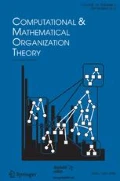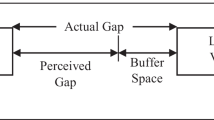Abstract
In this paper, a multi-value cellular automata model under Lagrange coordinates is proposed based on reality, the traffic flow in the Lagrange coordinate is simulated on the basis of the evolution equation of the model. From the fundamental diagram of the results under various conditions, it found that the three commonly used parameters of traffic flow in simulation is consistent with the empirical data. Specifically, traffic density and the number of lanes have a significant impact on traffic flow. The lower the density is, the more lanes there are, and the greater the flow. The research of this paper can help to develop more advanced traffic research technology, and improve the efficiency of traffic work subsequently. Simultaneously, it will bring convenience to people and promote the development of green traffic.







Similar content being viewed by others
References
Aw A, Rascle M (2002) Derivation of continuum traffic flow models from microscopic follow-the-leader models. SIAM J Appl Math 63(1):259–278
Barlovic R, Santen L, Schadschneider A et al (1998) Metastable states in cellular automata for traffic flow. Eur Phys J B 5(3):793–800
Bastien C (2009) Cellular automata modeling of physical systems. In: Meyers R (ed) Encyclopedia of complexity and systems science. Springer, New York. https://doi.org/10.1007/978-0-387-30440-3_57
Cobo MJ, Chiclana F, Collop A et al (2014) A Bibliometric analysis of the intelligent transportation systems research based on science mapping. IEEE Trans Intell Transp Syst 15(2):901–908
Fukui M, Ishibashi Y (1999) Traffic flow in 1D cellular automaton model including cars moving with high speed. J Phys Soc Jpn 65(6):1868–1870
Greenberg JM (2000) Extensions and amplifications of a traffic model of aw and rascle. SIAM J Appl Math 62(3):729–745
Greenberg JM (2004) Congestion redux. SIAM J Appl Math 64(4):1175–1185
Helbing D, Hennecke A (1999) Phase diagram of traffic states in the presence of in homogeneities. Phys Rev Lett 82:4360–4363
Hussein D, Sakda P (2007) Modelling drivers’ compliance and route choice behavior in response to travel information. Nonlinear Dyn 49(4):493–509
Junta M, Katsuhiro N (2003) Euler-Lagrange correspondence of generalized burgers cellular automaton. Int J Mod Phys C 15(4):507–515
Kerner BS (2004) Three-phase traffic theory and highway capacity. Physica A 333(1):379–440
Kerner BS, Konhäuser P (1994) Structure and parameters of clusters in traffic flow. Phys Rev e: Stat Phys, Plasmas, Fluids, 50(1):54–83
Kerner BS, Klenov SL, Konhäuser P (1997) Asymptotic theory of traffic jams. Phys Rev E 56(4):4200–4216
Kerner BS, Klenov SL, Wolf DE (2002a) Cellular automata approach to three-phase traffic theory. J Phys a: Gen Phys 5(47):9971–10013
Kerner BS, Klenov SL, Wolf DE (2002) Cellular automata approach to three-phase traffic theory. J Phys A Gen Phys 35(47):9971–10013
Kerner BS, Koller M, Klenov SL et al (2015) Empirical features of spontaneous and induced traffic breakdowns in free flow at highway bottlenecks. Physics 8(2):136–141
Kurtze DA, Hong DC (1995) Traffic jams, granular flow, and soliton selection. Phys Rev E: Stat Phys, Plasmas, Fluids, 52(1):218–221
Leclercq L (2007) Hybrid approaches to the solutions of the “Lighthill–Whitham–Richards” model. Transp Res Part B Methodol 41(41):701–709
Leclercq L, Laval JA, Chevallier E (2007) The lagrangian coordinates and what it means for first order traffic flow models. Elsevier, New York, pp 735–753
Li XG, Gao ZY, Zhao XM et al (2008) multivalue cellular automata model for mixed non-motorized traffic flow. Acta Phys Sin 57(8):4777–4785
Lighthill MJ, Whitham GB (1955) On kinematic waves. II. A theory of traffic flow on long crowded roads. Proc Royal Soci A Math Phys Eng Sci 299(1178):317–345
Liu DQ, Fu YS (1990) Lagrange coordinate traffic flow simulation theory. Urban Roads Bridg Flood Control 2:18–24
Machado JAT, Figueiredo L (2007) Special issue on modelling and control of intelligent transportation systems (ITS). Nonlinear Dyn 49(4):443–444
Martin S, Helbing N (2009) Criticism of three-phase traffic theory. Trans Res Part B Methodol 43(7):784–797
Muramatsu M, Nagatani T (1999) Soliton and kink jams in traffic flow with open boundaries. Phys Rev E 60(1):180–187
Nagatani T (1998) Thermodynamic theory for the jamming transition in traffic flow. Phys Rev E 58(4):4271–4276
Nagel K, Schreckenberg M (1992) A cellular automaton model for freeway traffic. J Phys I 2(12):2221–2229
Nishinari K (2000) multivalue cellular automaton models and metastable states in a congested phase. J Phys A Gen Phys 33(43):7709
Nishinari K (2001) A Lagrange representation of cellular automaton traffic-flow models. J Phys A Gen Phys 34(48):10727
Nishinari K, Takahashi D (1998) Analytical properties of ultradiscrete Burgers equation and rule-184 cellular automaton. J Phys A Gen Phys 31(24):5439
Nishinari K, Takahashi D (1999) A new deterministic CA model for traffic flow with multiple states. J Phys A Math Gen 32(1):93–104
Nishinari K, Fukui M, Schadschneider A (2003) A stochastic cellular automaton model for traffic flow with multiple metastable states. J Phys A Gen Phys 37(9):3101–3110
Ou ZH, Dai SQ, Zhang P et al (2007) Nonlinear analysis in the aw-rascle anticipation model of traffic flow. SIAM J Appl Math 67(3):605–618
Peng Z (2006) Characteristic parameters of a wide cluster in a higher-order traffic flow model. Chin Phys Lett 23(2):516–519
Richards PI (1956) Shock waves on the highway. Oper Res 4(1):42–51
Sussams JE (1972) Kinetic theory of vehicular traffic. Journal of the Operational Research Society 23(4):599–600
Teruhisa SK., Physics DO (1996) Kink Soliton characterizing traffic congestion (Abstracts of Doctoral Dissertations, annual report (from April 1995 to March 1996)). Science Reports of the Tohoku University.ser Physics & Astronomy. 17: 159–160
Treiber M, Kesting A, Helbing D (2010) Three-phase traffic theory and two-phase models with a fundamental diagram in the light of empirical stylized facts. Transp Res Part B 44(8):983–1000
Kessels F, Lint JWC, Hoogendoorn S, Vuik C (2009) Multiple user classes in the kinematic wave model in Lagrangian coordinates. Conference: Traffic and Granular Flow '09. https://www.researchgate.net/publication/260298315_Multiple_user_classes_in_the_kinematic_wave_model_in_Lagrangian_coordinates
Wang FY, Broggi A, White CC (2009) Road to transactions on intelligent transportation systems: a decade’s success. IEEE Trans Intell Transp Syst 10(4):553–556
Wu CX, Zhang P, Dai SQ (2007) Asymptotic solution of a wide cluster in Kühne higher-order traffic flow model. In Proceedings of the 5th International Conference on Nonlinear Mechanics. Shanghai, 1132–1136
Xu RY, Zhang P, Dai SQ et al (2007) Admissibility of a wide cluster solution in “anisotropic” higher-order traffic flow models. SIAM J Appl Math 68(2):562–573
Yu S, Tang J, Xin Q (2017) Relative velocity difference model for the car-following theory. Nonlinear Dyn 91:1–14
Zeng JW, Yang XG, Qian YS et al (2017) Research on three-phase traffic flow modeling based on interaction range. Mod Phys Lett B 31(35):1750328
Zhang P, Wong SC (2006) Essence of conservation forms in the traveling wave solutions of higher-order traffic flow models. Phys Rev E 74(2):026109
Acknowledgements
This work is jointly supported by the National Natural Science Foundation of China (Grant No. 71861024), the Major Research Plan of Gansu Province (Grant No. 21YF5GA052), the 2021 Gansu Higher Education Industry Support Plan (Grant No.2021CYZC-60), the “Double-First Class” Major Research Programs, Educational Department of Gansu Province (Grant No. GSSYLXM-04) and the United Fund of Lanzhou Jiaotong University and Tianjin University (Grant No. 2021057).
Author information
Authors and Affiliations
Corresponding author
Additional information
Publisher's Note
Springer Nature remains neutral with regard to jurisdictional claims in published maps and institutional affiliations.
Rights and permissions
About this article
Cite this article
Zeng, J., Qian, Y., Yin, F. et al. A multi-value cellular automata model for multi-lane traffic flow under lagrange coordinate. Comput Math Organ Theory 28, 178–192 (2022). https://doi.org/10.1007/s10588-021-09345-w
Accepted:
Published:
Issue Date:
DOI: https://doi.org/10.1007/s10588-021-09345-w




